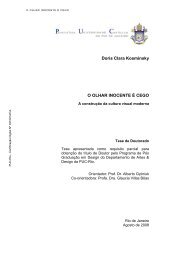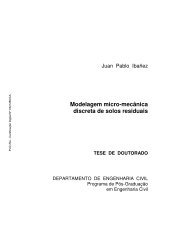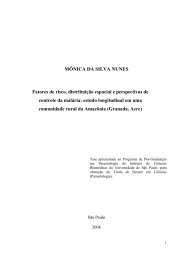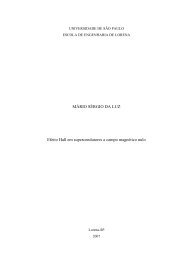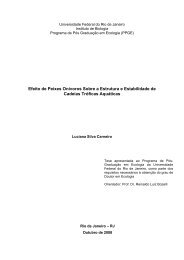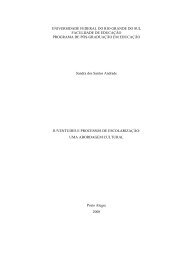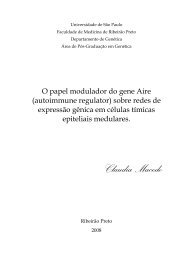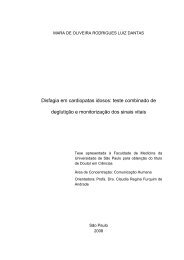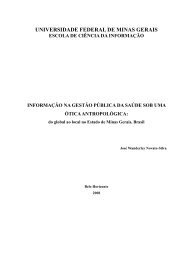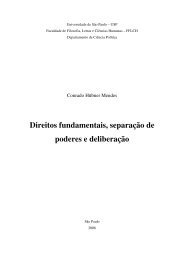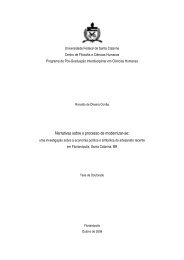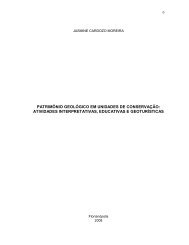- Page 2 and 3:
AUTOBIOGRAFIARodrigo Cristiano nasc
- Page 5 and 6:
Rodrigo CristianoMATERIAIS MOLECULA
- Page 7 and 8:
À minha esposa Cláudia.
- Page 9 and 10:
VÍNDICEINTRODUÇÃO ..............
- Page 11 and 12:
VIILISTA DE FIGURASFigura 1. Proces
- Page 13 and 14:
IXFigura 31. Espectro de RMN de 1 H
- Page 15 and 16:
XIFigura 63. Espectros de (a) UV e
- Page 17 and 18:
XIIILISTA DE TABELASTabela 1. Os ti
- Page 19 and 20:
XVTGA - Análise termogravimétrica
- Page 21 and 22:
XVIIABSTRACTThe synthesis and chara
- Page 23 and 24:
Introdução 19A química orgânica
- Page 25 and 26:
Introdução 21fenômenos possuem t
- Page 27 and 28:
Introdução 23elétrico é aplicad
- Page 29 and 30:
Introdução 25(Figura 3). A verdad
- Page 31 and 32:
Introdução 27investigar a conexã
- Page 33 and 34:
Introdução 29com um banco de dado
- Page 35 and 36:
Introdução 31descrever a estrutur
- Page 37 and 38:
Introdução 33Nas fases esméticas
- Page 39 and 40:
Introdução 35OHC 6 H 13OOOC 11 H
- Page 41 and 42:
Introdução 37O interesse na sínt
- Page 43 and 44:
Introdução 39Figura 17. Represent
- Page 45 and 46:
Introdução 41Figura 19. Esquema d
- Page 47 and 48:
Introdução 43mais comum nesses ma
- Page 49 and 50:
Introdução 45formam estruturas su
- Page 51 and 52:
Introdução 47do material quando n
- Page 53 and 54:
Introdução 491,3,4-oxadiazolN NOO
- Page 55 and 56:
Introdução 51R 2 OR 1OR 2N N ONON
- Page 57 and 58:
Introdução 53estável através de
- Page 59 and 60:
RESULTADOS EDISCUSSÃO
- Page 61 and 62:
Resultados e Discussão 57aromátic
- Page 63 and 64:
Resultados e Discussão 59Esquema 3
- Page 65 and 66:
Resultados e Discussão 61mantendo-
- Page 67 and 68:
Resultados e Discussão 63(ν C≡C
- Page 69 and 70:
Resultados e Discussão 65funcional
- Page 71 and 72:
Resultados e Discussão 67ROORROOO4
- Page 73 and 74:
Resultados e Discussão 69Uma rota
- Page 75 and 76:
Resultados e Discussão 71baNNOc d
- Page 77 and 78:
Resultados e Discussão 73Tabela 3.
- Page 79 and 80:
Resultados e Discussão 75Para o co
- Page 81 and 82:
Resultados e Discussão 77porque o
- Page 83 and 84:
Resultados e Discussão 795. CLs cu
- Page 85 and 86:
Resultados e Discussão 81gerado a
- Page 87 and 88:
Resultados e Discussão 835.2. Prop
- Page 89 and 90:
Resultados e Discussão 85(a)Cr-CrC
- Page 91 and 92:
Resultados e Discussão 87(a)(b)Fig
- Page 93 and 94:
Resultados e Discussão 89Esses com
- Page 95 and 96:
Resultados e Discussão 91catalíti
- Page 97 and 98:
Resultados e Discussão 93a complet
- Page 99 and 100:
Resultados e Discussão 95A banda l
- Page 101 and 102:
Resultados e Discussão 97constante
- Page 103 and 104:
Resultados e Discussão 99A não-pl
- Page 105 and 106:
Resultados e Discussão 101(a)(b)T
- Page 107 and 108:
Resultados e Discussão 103(e)trans
- Page 109 and 110:
Resultados e Discussão 1056.5. Pro
- Page 111 and 112:
Resultados e Discussão 107composto
- Page 113 and 114:
Resultados e Discussão 109composto
- Page 115 and 116:
Resultados e Discussão 1117. Tris-
- Page 117 and 118:
Resultados e Discussão 113Esquema
- Page 119 and 120:
Resultados e Discussão 115A caract
- Page 121 and 122:
Resultados e Discussão 117ppm rela
- Page 123 and 124:
Resultados e Discussão 1197.2. Est
- Page 125 and 126:
Resultados e Discussão 121Figura 7
- Page 127 and 128:
Resultados e Discussão 123N21-N22
- Page 129 and 130:
Resultados e Discussão 125método
- Page 131 and 132:
Resultados e Discussão 127após lo
- Page 133 and 134:
Resultados e Discussão 129baseado
- Page 135 and 136:
Resultados e Discussão 131aquecime
- Page 137 and 138:
Resultados e Discussão 133composto
- Page 139 and 140:
Resultados e Discussão 1357.5. Est
- Page 141 and 142:
Resultados e Discussão 137estabili
- Page 143 and 144:
Conclusões 1398. CONCLUSÕESEm ger
- Page 145 and 146:
SEÇAO EXPERIMENTAL
- Page 147 and 148:
Seção Experimental 143respectivam
- Page 149 and 150:
Seção Experimental 1457,08 (m, 2H
- Page 151 and 152:
Seção Experimental 147K 2 CO 3 (7
- Page 153 and 154:
Seção Experimental 149H, -CH 2 NC
- Page 155 and 156:
Seção Experimental 1512918, 2851,
- Page 157 and 158:
Seção Experimental 153Esse compos
- Page 159 and 160:
Seção Experimental 155Espectro de
- Page 161 and 162:
Seção Experimental 157Este compos
- Page 163 and 164:
Seção Experimental 159H 21 C 10 O
- Page 165 and 166:
Seção Experimental 16114,36; 22,9
- Page 167 and 168:
Seção Experimental 163H), 6,85 (d
- Page 169 and 170: Seção Experimental 165NCNCNNHO59O
- Page 171 and 172: Seção Experimental 167H 21 C 10 O
- Page 173 and 174: Seção Experimental 169(sílica-ge
- Page 175 and 176: Seção Experimental 171dodeciloxib
- Page 177 and 178: Seção Experimental 173NCNCNNOOOOC
- Page 179 and 180: Seção Experimental 175Análise el
- Page 181 and 182: Seção Experimental 177Espectro de
- Page 183 and 184: Seção Experimental 179131,6; 132,
- Page 185 and 186: Seção Experimental 181Espectro de
- Page 187 and 188: Seção Experimental 183fornecendo
- Page 189 and 190: Seção Experimental 185Espectro de
- Page 191 and 192: Referências bibliográficas 18710.
- Page 193 and 194: Referências bibliográficas 189pha
- Page 195 and 196: Referências bibliográficas 19149.
- Page 197 and 198: Referências bibliográficas 19371.
- Page 199 and 200: Referências bibliográficas 19596.
- Page 201 and 202: Referências bibliográficas 197120
- Page 203 and 204: 382 R. Cristiano et al.acetylenes 1
- Page 205 and 206: 384 R. Cristiano et al.Scheme 2. Re
- Page 207 and 208: 386 R. Cristiano et al.Table 3. Sum
- Page 209 and 210: 388 R. Cristiano et al.117.0-125.4u
- Page 211 and 212: 390 Hockey stick-shaped LC compound
- Page 213 and 214: LSYC146630 LSYC_036_007 Techset Com
- Page 215 and 216: LSYC146630 LSYC_036_007 Techset Com
- Page 217 and 218: LSYC146630 LSYC_036_007 Techset Com
- Page 219: LSYC146630 LSYC_036_007 Techset Com
- Page 223 and 224: 1000 R. Cristiano et al.(a)(b)Figur
- Page 225 and 226: 1002 R. Cristiano et al.4.3.2. 1-(4
- Page 227 and 228: Tetrahedron 63 (2007) 2851-2858Synt
- Page 229 and 230: R. Cristiano et al. / Tetrahedron 6
- Page 231 and 232: R. Cristiano et al. / Tetrahedron 6
- Page 233 and 234: R. Cristiano et al. / Tetrahedron 6
- Page 235 and 236: COMMUNICATIONwww.rsc.org/chemcomm |
- Page 237: In summary, we performed the synthe



